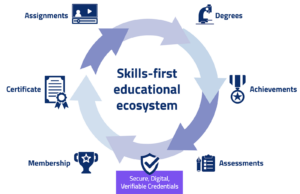Blog
Our latest insights on education, assessments, and employability.
Open Badges 3.0 — New Capabilities and Use Cases for Digital Credentialing

We are closer than ever to a skills-first educational ecosystem. The final approval of the Open Badges 3.0 (OB3) standard from 1EdTech is a significant step toward the technology needed to digitize educational achievements, providing dimension on the skills and competencies they include.
As an early implementor, Territorium is working on deployments with many different types of educational institutions. While OB3 has many opportunities, it is also essential to stay aware of the flexibility and complexity and focus on the strategic and practical ways to implement it for the most significant benefit of your learners. There are several vital considerations if you are new to issuing digital credentials or if you are planning to upgrade a prior implementation of the OB standard. You also want to keep an eye for the future and be aware of how your implementation might rely on related standards like the Comprehensive Learner Record (CLR).
It’s all in the achievement
One of the most important parts of the new Open Badges 3.0 (OB3) standard is the addition of an “achievement type” field, allowing you to make your credentials truly be more than just “badges.” Achievement types can be listed for more minor activities like assessments, assignments, certificates, or courses. However, co-curricular activities, awards, memberships, and more official credentials such as micro-credentials, degree programs, or even official licensures are also possible.
If you are an employer trying to understand and verify open badges in your job applicants, focusing on the achievement type field clarifies whether this badge meets your requirements for certain educational degrees or certifications or represents some evidence of a particular skill.
If you are an institutional issuer, OB3 offers you many opportunities to implement credentials in academic and student life settings. You can also associate related information such as field of study, language, learning outcomes, evidence, and actual results in the form of grades or scores. Don’t let the massive flexibility slow your implementation or migration to the new standard.
Start with skills
The implementation of open badges for micro-credential or degree programs is evident. With the enhanced variety of achievement types in OB3, it may be harder to determine what other types of credentials to issue to determine your policy and approach for the institution.
My advice is to start with skills. The most in-demand job skills are hidden in many things within courses or campus leadership activities. Understanding the skills, knowledge, and capabilities with which you expect your students to leave your institution can serve as a north star for making decisions about credentialing. Of course, knowledge and technical skills are learned and taught in traditional settings, but hundreds of durable skills are being learned in so many more experiences.
Find where those skills are evidenced to pilot new programs. If the application of skill development varies, for example, skills are being built in one instructor’s course and not others, this may present the perfect opportunity to change to a skills-first approach in more courses that show success with these new types of credentials.
Look to the future with CLR
CLR 2.0 is the latest version of the Comprehensive Learner Record (CLR) standard, which is now in candidate final status and may soon be finalized. Handily, it shares much of the same structure as open badges. It also allows you to aggregate many open badges into one comprehensive record of what credentials you have issued to a learner.
As you think about aligning your implementation of OB3 with future uses of CLR, some key decisions you want to agree on are whether you plan to issue formal programs like degrees or micro-credentials as individual open badges or if you’re going to use a CLR to aggregate them. Some institutions may prefer a simple approach of one badge. Others may want to badge courses and aggregate a degree program with a CLR. In contrast, some might prefer to be skills-first and badge for assessment of skills aggregated in a CLR focused on competencies.
The flexibility is up to you, but you do need to decide on an approach so that you can effectively implement the program with the required processes and technology. You also want to be clear about when you plan to issue these credentials. Are they only issued when the programs are complete, or are you incrementally allowing learners to accumulate them?
With so many options, the finalization of OB3 is a fantastic step forward in the capability to issue credentials that truly detail a learner’s skill and competency. It is also important to remember that this technology is new for institutions and learners of all ages. Thinking beyond degrees, including experiential badges as part of your credentialing, allows you to pilot and improve your issuance process. It is also a way to make digital credentials ubiquitous across campus so your learners can leave your institution knowing how and why to use them.